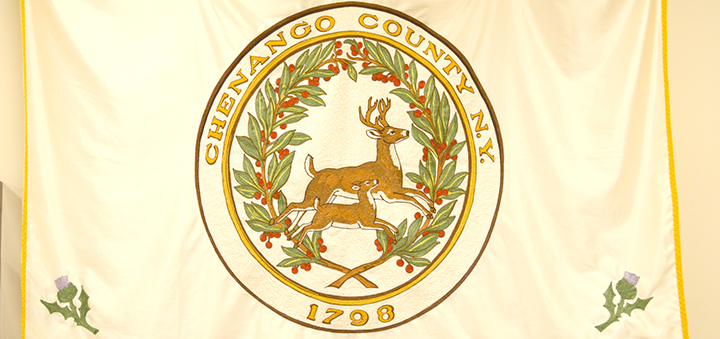Despite Inflation, County Will Adhere To State-imposed Tax Cap
Published:
July 19th, 2022
By:
Shawn Magrath
 The official seal of Chenango County hangs in the board of supervisors meeting room at the Chenango County Office Building. (Photo by Tyler Murphy)
The official seal of Chenango County hangs in the board of supervisors meeting room at the Chenango County Office Building. (Photo by Tyler Murphy)
CHENANGO COUNTY – In spite of high inflation, the Chenango County Treasurer’s Office says it can stay below the state-imposed 2 percent tax cap – at least for the time being.
Although variabilities in state guidelines change from year to year, the county has tarried below the property tax levy growth cap since the initiative was first ordered by the state in 2012. The NYS Comptroller’s Office announced last week that local governments – counties, towns and fire districts – must again adhere to the 2 percent cap for the 2023 fiscal year, although that includes an inflation factor of 7.17 percent.
If inflation stays high, it could spell trouble for day-to-day operations, according to Chenango County officials, and the county may face tough decisions for its approximate $100-plus million annual budget for 2024 and beyond.
“We’re proud of the fact that we’ll meet the cap and avoid debt next year. We’re one of only two or three counties in the state without debt,” said Chenango County Treasurer Bill Craine. “But going forward, for 2025 and 2026, if inflation stays at 7 or 8 percent, or even mitigated to 5 or 6 percent, it becomes increasingly difficult to adhere to the cap.”
Presently the county has solid financial footing, said Craine, with more than $22 million in its reserve – enough to fund county operations for two months without borrowing. The county’s now spending at a rate of about $7.5 million per month and using nearly $1 million from reserves each year to balance the budget.
“We would like to eliminate that,” said Craine, noting that while the county has made large strides in bringing down the amount drawn from reserves each year by nearly 75 percent, county officials aspire not to draw any.
“We would like to get to zero so that each budget stands entirely on its own,” he said. “With inflation, we don’t know if that will be possible.”
The biggest obstacles? Increasing fuel costs and a wage base for county employees that, in previous years, has tracked inflation.
The county currently handles a wage base of roughly $25 million with benefit costs on top of that. If the wage base increases by 4 percent annually, it becomes increasingly difficult to adhere to the tax cap over time. What’s more, fuel prices have impacted almost every facet of county government, namely the county’s department of public works. Officials are bracing for a possible 25 to 50 percent increase in its energy budget next year if fuel costs remain high.
“We’re in a strong position with our reserves now,” said Craine. “We’re optimistic that we’ll continue meeting the tax cap, but inflation does impact us.”
“Just as local governments are receiving their final round of federal funding under the American Rescue Plan Act, they are facing economic challenges that will likely drive costs higher than expected or planned, making it harder to adhere to the tax cap as they prepare their budgets for 2023,” said NYS Comptroller Thomas DiNapoli.
DiNapoli said given this year’s inflation factor calculation of 7.71 percent, a majority of New York’s counties, towns and calendar year cities and villages could see cost increases that exceed the amounts they’re set to receive in their final round of American Rescue Plan (ARPA) funds.
The tax cap limits annual tax levy increases to the lesser of the rate of inflation or 2 percent with certain exceptions. The inflation factor is the highest it’s been since the tax cap was first implemented.
Author: Shawn Magrath - More From This Author
Comments










